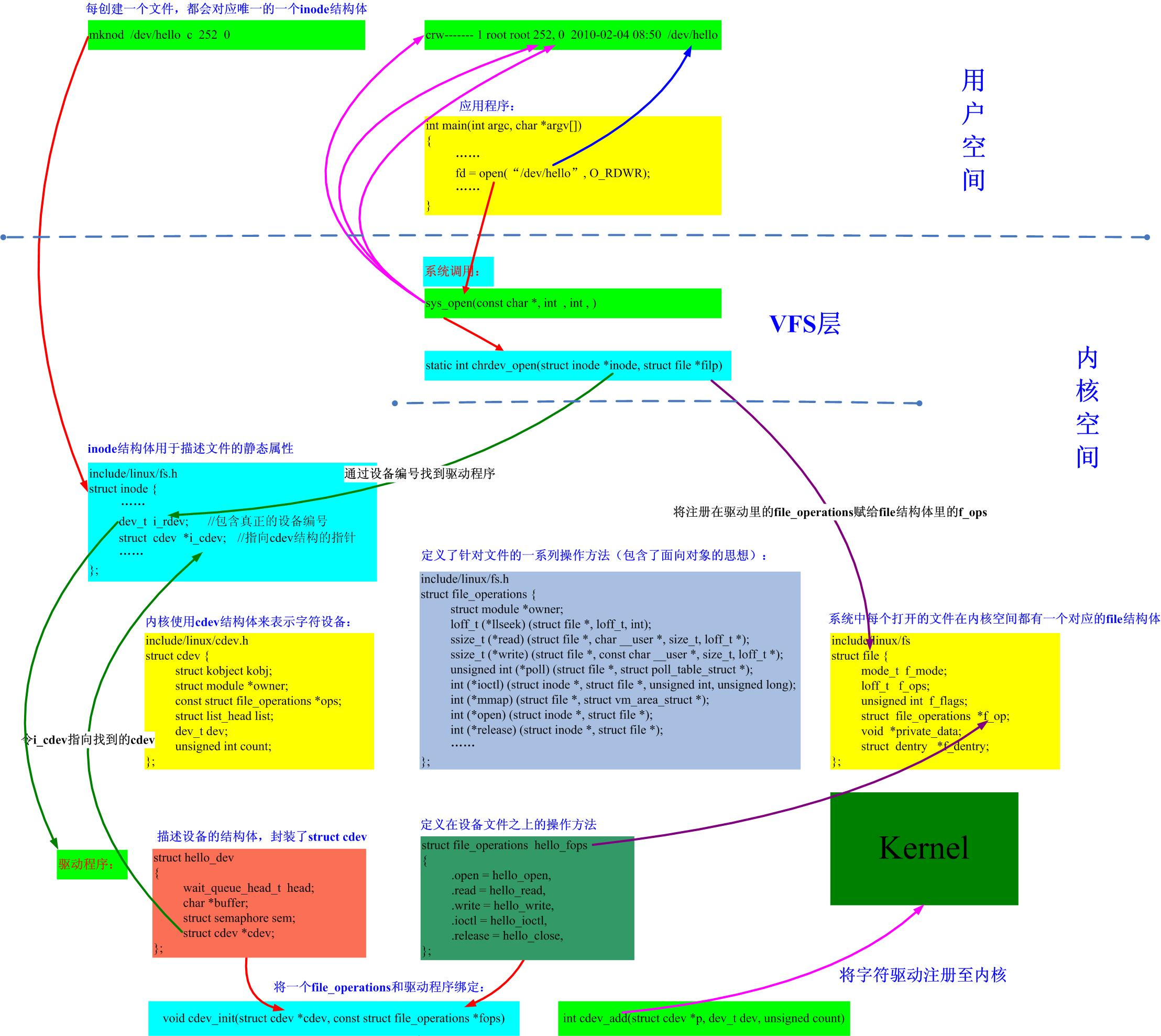设备文件是Linux系统中一种特殊的文件,它用来表示设备的接口,使得用户空间的程序可以通过文件操作来访问设备。设备文件的实现涉及到三个重要的结构体:inode,file和file_operations。inode结构体用来存储设备文件的元数据,如设备号,权限,大小等。file结构体用来存储设备文件的状态信息,如当前位置,打开模式,私有数据等。file_operations结构体用来存储设备文件的操作函数,如open,read,write,close等。在本文中,我们将介绍这三个结构体的定义和作用,并举例说明它们的使用方法和注意事项。

驱动程序就是向下控制硬件,向上提供接口,这里的向上提供的接口最终对应到应用层有三种方式:设备文件,/proc,/sys,其中最常用的就是使用设备文件,而Linux设备中用的最多的就是字符设备,本文就以字符设备为例来分析创建并打开一个字符设备的文件内部机制。
struct inode
Linux中一切皆文件,当我们在Linux中创建一个文件时,就会在相应的文件系统创建一个inode与之对应,文件实体和文件的inode是一一对应的,创建好一个inode会存在存储器中,第一次open就会将inode在内存中有一个备份,同一个文件被多次打开并不会产生多个inode,当所有被打开的文件都被close之后,inode在内存中的实例才会被释放。既然如此,当我们使用mknod(或其他方法)创建一个设备文件时,也会在文件系统中创建一个inode,这个inode和其他的inode一样,用来存储关于这个文件的静态信息(不变的信息),包括这个设备文件对应的设备号,文件的路径以及对应的驱动对象etc。inode作为VFS四大对象之一,在驱动开发中很少需要自己进行填充,更多的是在open()方法中进行查看并根据需要填充我们的file结构。
对于不同的文件类型,inode被填充的成员内容也会有所不同,以创建字符设备为例,我们知道,add_chrdev_region其实是把一个驱动对象和一个(一组)设备号联系到一起。而创建设备文件,其实是把设备文件和设备号联系到一起。至此,这三者就被绑定在一起了。这样,内核就有能力创建一个struct inode实例了,下面是4.8.5内核中的inode。这个inode是VFS的inode,是最具体文件系统的inode的进一步封装,也是驱动开发中关心的inode,针对具体的文件系统,还有struct ext2_inode_info 等结构。
//include/linux/fs.h
596 /*
597 * Keep mostly read-only and often accessed (especially for
598 * the RCU path lookup and 'stat' data) fields at the beginning
599 * of the 'struct inode'
600 */
601 struct inode {
602 umode_t i_mode;
603 unsigned short i_opflags;
604 kuid_t i_uid;
605 kgid_t i_gid;
606 unsigned int i_flags;
607
608 #ifdef CONFIG_FS_POSIX_ACL
609 struct posix_acl *i_acl;
610 struct posix_acl *i_default_acl;
611 #endif
612
613 const struct inode_operations *i_op;
614 struct super_block *i_sb;
615 struct address_space *i_mapping;
616
617 #ifdef CONFIG_SECURITY
618 void *i_security;
619 #endif
620
621 /* Stat data, not accessed from path walking */
622 unsigned long i_ino;
623 /*
624 * Filesystems may only read i_nlink directly. They shall use the
625 * following functions for modification:
626 *
627 * (set|clear|inc|drop)_nlink
628 * inode_(inc|dec)_link_count
629 */
630 union {
631 const unsigned int i_nlink;
632 unsigned int __i_nlink;
633 };
634 dev_t i_rdev;
635 loff_t i_size;
636 struct timespec i_atime;
637 struct timespec i_mtime;
638 struct timespec i_ctime;
639 spinlock_t i_lock; /* i_blocks, i_bytes, maybe i_size */
640 unsigned short i_bytes;
641 unsigned int i_blkbits;
642 blkcnt_t i_blocks;
643
644 #ifdef __NEED_I_SIZE_ORDERED
645 seqcount_t i_size_seqcount;
646 #endif
647
648 /* Misc */
649 unsigned long i_state;
650 struct rw_semaphore i_rwsem;
651
652 unsigned long dirtied_when; /* jiffies of first dirtying */
653 unsigned long dirtied_time_when;
654
655 struct hlist_node i_hash;
656 struct list_head i_io_list; /* backing dev IO list */
657 #ifdef CONFIG_CGROUP_WRITEBACK
658 struct bdi_writeback *i_wb; /* the associated cgroup wb */
659
660 /* foreign inode detection, see wbc_detach_inode() */
661 int i_wb_frn_winner;
662 u16 i_wb_frn_avg_time;
663 u16 i_wb_frn_history;
664 #endif
665 struct list_head i_lru; /* inode LRU list */
666 struct list_head i_sb_list;
667 struct list_head i_wb_list; /* backing dev writeback list */
668 union {
669 struct hlist_head i_dentry;
670 struct rcu_head i_rcu;
671 };
672 u64 i_version;
673 atomic_t i_count;
674 atomic_t i_dio_count;
675 atomic_t i_writecount;
676 #ifdef CONFIG_IMA
677 atomic_t i_readcount; /* struct files open RO */
678 #endif
679 const struct file_operations *i_fop; /* former ->i_op->default_file_ops */
680 struct file_lock_context *i_flctx;
681 struct address_space i_data;
682 struct list_head i_devices;
683 union {
684 struct pipe_inode_info *i_pipe;
685 struct block_device *i_bdev;
686 struct cdev *i_cdev;
687 char *i_link;
688 unsigned i_dir_seq;
689 };
690
691 __u32 i_generation;
692
693 #ifdef CONFIG_FSNOTIFY
694 __u32 i_fsnotify_mask; /* all events this inode cares about */
695 struct hlist_head i_fsnotify_marks;
696 #endif
697
698 #if IS_ENABLED(CONFIG_FS_ENCRYPTION)
699 struct fscrypt_info *i_crypt_info;
700 #endif
701
702 void *i_private; /* fs or device private pointer */
703 };
这里面与本文相关的成员主要有:
“
struct inode
–602–>i_mode表示访问权限控制
–604–>UID
–605–>GID
–606–>i_flags文件系统标志
–630–>硬链接数计数
–635–>i_size以字节为单位的文件大小
–636–>最后access时间
–637–>最后modify时间
–638–>最后change时间
–669–>i_dentry; //目录项链表
–673–>i_count引用计数,当引用计数变为0时,会释放inode实例
–675–>i_writecount写者计数
–679–>创建设备文件的时候i_fops填充的是def_chr_fops,blk_blk_fops,def_fifo_fops,bad_sock_fops之一,参见创建过程中调用的init_special_inode()
–683–>特殊文件类型的union,pipe,cdev,blk.link etc,i_cdev表示这个inode属于一个字符设备文件,本文中创建设备文件的时候会把与之相关的设备号的驱动对象cdev拿来填充
–702–>inode的私有数据”
上面的几个成员只有struct def_chr_fops 值得一追,后面有大用:
//fs/char_dev.c
429 const struct file_operations def_chr_fops = {
430 .open = chrdev_open,
431 .llseek = noop_llseek,
432 };
struct file
Linux内核会为每一个进程维护一个文件描述符表,这个表其实就是struct file[]的索引。open()的过程其实就是根据传入的路径填充好一个file结构并将其赋值到数组中并返回其索引。下面是file的主要内容
//include/linux/fs.h
877 struct file {
878 union {
879 struct llist_node fu_llist;
880 struct rcu_head fu_rcuhead;
881 } f_u;
882 struct path f_path;
883 struct inode *f_inode; /* cached value */
884 const struct file_operations *f_op;
885
886 /*
887 * Protects f_ep_links, f_flags.
888 * Must not be taken from IRQ context.
889 */
890 spinlock_t f_lock;
891 atomic_long_t f_count;
892 unsigned int f_flags;
893 fmode_t f_mode;
894 struct mutex f_pos_lock;
895 loff_t f_pos;
896 struct fown_struct f_owner;
897 const struct cred *f_cred;
898 struct file_ra_state f_ra;f
904 /* needed for tty driver, and maybe others */
905 void *private_data;
912 struct address_space *f_mapping;
913 } __attribute__((aligned(4))); /* lest something weird decides that 2 is OK */
“
struct file
–882–>f_path里存储的是open传入的路径,VFS就是根据这个路径逐层找到相应的inode
–883–>f_inode里存储的是找到的inode
–884–>f_op里存储的就是驱动提供的file_operations对象,这个对象在open的时候被填充,具体地,应用层的open通过层层搜索会调用inode.i_fops->open,即chrdev_open()
–891–>f_count的作用是记录对文件对象的引用计数,也即当前有多少个使用CLONE_FILES标志克隆的进程在使用该文件。典型的应用是在POSIX线程中。就像在内核中普通的引用计数模块一样,最后一个进程调用put_files_struct()来释放文件描述符。
–892–>f_flags当打开文件时指定的标志,对应系统调用open的int flags,比如驱动程序为了支持非阻塞型操作需要检查这个标志是否有O_NONBLOCK。
–893–>f_mode;对文件的读写模式,对应系统调用open的mod_t mode参数,比如O_RDWR。如果驱动程序需要这个值,可以直接读取这个字段。
–905–>private_data表示file结构的私有数据”
我在Linux设备管理(二)_从cdev_add说起一文中已经分析过chrdev_open(),这里仅作概述。
//fs/chr_dev.c
348 /*
349 * Called every time a character special file is opened
350 */
351 static int chrdev_open(struct inode *inode, struct file *filp)
352 {
/* 搜索cdev */
...
390 replace_fops(filp, fops);
391 if (filp->f_op->open) {
392 ret = filp->f_op->open(inode, filp);
393 if (ret)
394 goto out_cdev_put;
395 }
...
402 }
可以看出,这个函数有三个任务(划重点!!!):
“
chrdev_open()
–352-389–>利用container_of等根据inode中的成员找到相应的cdev
–390–>用cdev.fops替换filp->f_op,即填充了一个空的struct file的f_op成员。
–392–>回调替换之后的filp->f_op->open,由于替换,这个其实就是cdev.fops”
至此,我们知道了我们写的驱动中的open()在何时会被回调,这样我们就可以实现很多有意思的功能,比如,
我们可以在open中通过inode->cdev来识别具体的设备,并将其私有数据隐藏到file结构的private_data中,进而识别同一个驱动操作一类设备;
我们也可以在回调cdev.fops->open()阶段重新填充file结构的fop,进而实现同一个驱动操作不同的设备,这种思想就是内核驱动中常用的分层!
最后总结一下这些结构之间的关系:
“
”
通过本文,我们了解了设备文件的三个重要的结构体:inode,file和file_operations。它们可以用来实现对设备文件的管理和操作。我们应该根据实际需求选择合适的结构体,并遵循一些基本原则,如使用正确的设备号,使用合理的权限,使用有效的操作函数等。设备文件的三个结构体是Linux系统中最基本的概念之一,它们可以实现对设备的抽象和封装,也可以提升系统的统一性和灵活性。希望本文能够对你有所帮助和启发。
以上就是良许教程网为各位朋友分享的Linu系统相关内容。想要了解更多Linux相关知识记得关注公众号“良许Linux”,或扫描下方二维码进行关注,更多干货等着你 !




 微信扫一扫打赏
微信扫一扫打赏
 支付宝扫一扫打赏
支付宝扫一扫打赏

.png)
